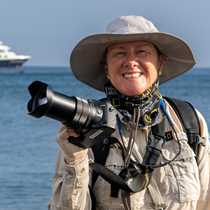Bartolomé & Santiago Islands
A light mist was present at six-thirty in the morning when folks started heading for the 372 wooden stair-climb to the top of Bartolomé Island. The intrepid aerobic non-stop-to-the-top groups went sailing up, while the more rational walkers took it easy, listening and taking photographs and all made it to the heights sooner or later.
The vista is iconic: crescent beaches on either side of green mangrove forest and golden dunes, which after breakfast were crossed to explore the southern beach. We are approaching marine turtle nesting season, so turtle heads pop up near most of the popular nesting beaches, Bartolomé no exception. Snorkeling was great, as was the glass bottom boat, both beneath the towering pinnacle rock of photographic fame.
Starting from early morning, we had seen splashes out in open water and soon identified the acrobatic leaps of mobula rays. Dark colored on their dorsal surface, they are brilliant white on their undersides. When they leap, they twist and twirl flashingly. Dozens, if not more, spread out over a great distance, yet together. They were seen jumping all day as we travelled the length of Santiago's northern coastline. These rays usually appear with the warmer waters from the northeast…harbingers of seasonal change perhaps?
The afternoon was spent at Puerto Egas, James Bay. Old pirate haunt and later salt mine settlement, and now National Park. High tides had the wildlife along the coast piled up near the trail, in areas so dense "you almost tripped over them" said Deb H. Galápagos sea lions, Santiago marine iguanas, furseals, they all accepted each other's presence as natural, and to be ourselves ignored was to feel also accepted by this web of life, if only for a little while.
Those who chose snorkelling had one last chance to hover with the marine turtles as they grazed the algae. A juvenile sea lion stole my thermometer when it slipped from my wrist - and never considered giving it back. A tube anemone blossomed on the floor of the bay, near the beach of black sand: Botruanthus benedeni.
So much to absorb, so many emotions to take back and think about. This last evening together it was heart-warming to hear how this journey has changed some lives. Some are returning home now more aware of what they purchase to eat; ask questions about sources; buy sustainable foods, recycle more, lessen our impact on the environment, and learn how we can become better stewards of our earth.



